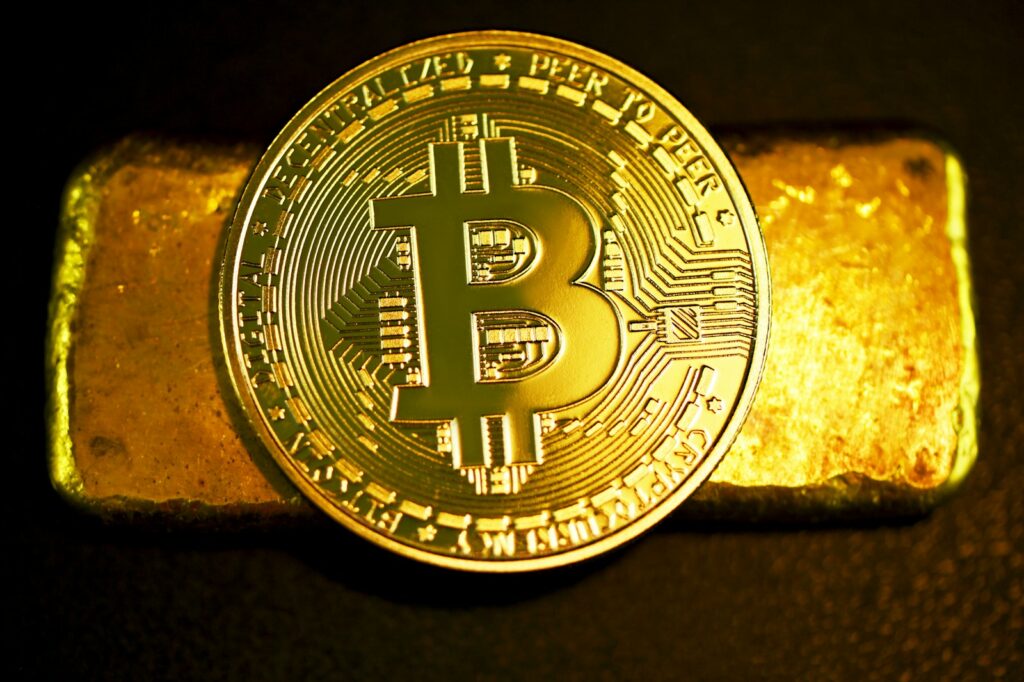Main Points :
- Rising inflation and digitization are accelerating Bitcoin adoption as an alternative to gold.
- Institutional investors are increasingly integrating Bitcoin into their portfolios.
- Optimists see Bitcoin as the new standard for digital currency, while skeptics warn of regulatory and technical challenges.
- Bitcoin’s high volatility sparks debates: is it a gamble or an investment in the future?
- The future of Bitcoin remains uncertain, but its potential impact on global finance is undeniable.
The Rise of Bitcoin as Digital Gold
For centuries, gold has been synonymous with wealth preservation and financial security. Yet, the emergence of Bitcoin as “digital gold” is challenging the dominance of this traditional asset. With its limited supply, decentralized nature, and increasing mainstream acceptance, Bitcoin is being positioned as a viable alternative to gold. But can Bitcoin truly replace gold, or will it remain a high-risk investment for the tech-savvy few?
1. Inflation and Digitalization Drive Bitcoin Investment
Inflation Concerns Push Investors Towards Bitcoin
Inflationary pressures have reached unprecedented levels globally, eroding the purchasing power of fiat currencies. Traditionally, gold has served as a hedge against inflation. However, Bitcoin, with its capped supply of 21 million coins, offers a modern solution to the same problem. Its scarcity and decentralized architecture resonate with investors seeking protection from economic uncertainty.
The Appeal of Digital Assets
The world is becoming increasingly digital, and Bitcoin stands as the epitome of digital finance. For younger generations, particularly millennials and Gen Z, Bitcoin represents not just an investment but a paradigm shift in financial systems. Its role as a digital, borderless, and censorship-resistant asset is redefining how we view and store wealth.
2. Institutional Investors Enter the Bitcoin Market
From Skepticism to Adoption
Initially dismissed as a speculative bubble, Bitcoin is now gaining legitimacy among institutional investors. Major financial firms and pension funds are allocating portions of their portfolios to Bitcoin, recognizing its potential as a high-growth asset. Institutional participation has brought increased liquidity, reduced volatility, and enhanced credibility to the market.
The Domino Effect of Adoption
As more institutions embrace Bitcoin, they pave the way for broader acceptance. High-profile endorsements from companies like MicroStrategy and Tesla have fueled investor confidence, while Bitcoin ETFs make it easier for retail investors to gain exposure. This growing adoption signals a shift in perception from speculative asset to long-term investment.
3. Optimism vs. Skepticism: The Future of Bitcoin
The Optimist’s Perspective
Bitcoin advocates believe it could become the backbone of a decentralized financial system. Its transparency, immutability, and programmability make it suitable for use cases ranging from remittances to smart contracts. Optimists argue that as Bitcoin adoption grows, it will achieve stability, making it as reliable as traditional currencies or gold.
The Skeptic’s View
Critics caution against over-enthusiasm, citing potential obstacles such as regulatory crackdowns, scalability issues, and environmental concerns. Governments worldwide are implementing stricter controls over cryptocurrencies, fearing their potential to disrupt traditional financial systems. Additionally, Bitcoin’s energy-intensive mining process continues to attract negative scrutiny.

4. Is Bitcoin Investment Gambling or the Future of Finance?
Volatility: A Double-Edged Sword
Bitcoin’s meteoric price swings have both fascinated and frightened investors. For some, its volatility represents an opportunity for immense gains. For others, it’s a stark reminder of the risks associated with digital assets. This dichotomy fuels debates over whether Bitcoin is a speculative gamble or a strategic investment in the future.
A Symbol of Financial Revolution
Beyond its price, Bitcoin symbolizes a broader technological and financial revolution. It challenges centralized banking systems and offers financial inclusion to the unbanked. As a result, many view Bitcoin not merely as an investment but as a bet on the evolution of global finance.
5. Key Considerations for Bitcoin Investors
Acquire Knowledge
Before diving into Bitcoin investment, it’s crucial to understand its fundamentals, risks, and market dynamics.
Diversify Investments
Allocating all assets to Bitcoin is a risky strategy. Diversification across multiple asset classes, including stocks, bonds, and gold, can mitigate risks.
Adopt a Long-Term View
Short-term price fluctuations are inevitable. Investors who maintain a long-term perspective may better navigate Bitcoin’s volatility and reap substantial rewards.
The Uncertain Yet Promising Future of Bitcoin
Bitcoin’s journey from an obscure experiment to a trillion-dollar asset class is nothing short of extraordinary. While its future remains uncertain, one thing is clear: Bitcoin has already made an indelible mark on the global financial landscape. Whether it ultimately supplants gold or remains a complementary asset, Bitcoin’s role in reshaping the concept of value and investment cannot be ignored.
For now, Bitcoin is both a high-risk, high-reward asset and a symbol of the possibilities of decentralized finance. As the world continues to evolve, the battle between Bitcoin and gold will undoubtedly shape the future of investments.


